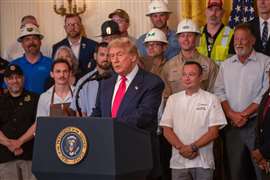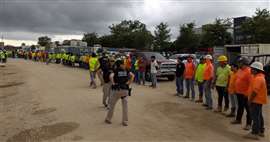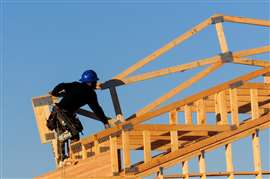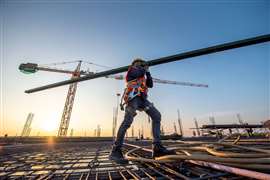Read this article in French German Italian Portuguese Spanish
Disappearing workforce: How US mass deportations could worsen construction’s labour crisis
04 July 2025
The US construction industry, already facing a chronic labour shortfall, now faces a deeper threat: immigration raids accelerating the disappearance of its workforce.
 US President Donald Trump speaks in front of a collection of workers to ask support for the One Big Beautiful Bill on 26 June 2025. (Image: Andrew Leyden/ZUMA Press Wire/Reuters Connect)
US President Donald Trump speaks in front of a collection of workers to ask support for the One Big Beautiful Bill on 26 June 2025. (Image: Andrew Leyden/ZUMA Press Wire/Reuters Connect)
Since President Donald Trump’s return to office, the US Immigration and Customers Enforcement (ICE) agency launched sweeping immigration raids across cities including Tallahassee, San Antonio, New Orleans, and Los Angeles, with average daily arrests jumping from 650 to 3,000. Added to it, a 23 June Supreme Court ruling has further cleared the way for rapid deportations.
Just last month, on 26 June, a series of arrests in Laredo, Texas, US, made local television news for dramatic video captured at the site: workers were recorded running across roads to escape ICE officers, while others hid on construction machines. In total, ICE said it arrested 24 undocumented workers.
Stories like these have become commonplace in the US, and it’s accelerating growing fears: both among the US’s large migrant workforce and economists who believe threatening up to one-third of the country’s construction labour pool could have significant negative consequences.
Chris Hoyes, a construction market analyst with US-based consultancy Roland Berger, tells Construction Briefing the spring and summer ICE raids are already creating an intangible impact.
“While I don’t have hard data yet, I’m hearing from clients that these actions are making it harder to staff projects, especially in lower-skilled trades,” Hoyes says. “Workers are simply not showing up as they used to, leading to delays and, inevitably, higher costs. These early signs suggest that enforcement is already impacting project timelines and budgets in noticeable ways.”
But what comes next, how concerned should US construction be about losing a large chunk of its workforce, and what can contractors do in response?
Construction’s labour shortfall to get worse amid deportations
The first reality to accept is the issue isn’t going away. Industry leadership is expecting that ICE’s activity will accelerate through Trump’s second term, not slow down. And more funding to deport migrants could be coming, after the US Senate passed Trump’s “One Big Beautiful Bill” on 1 July. That bill, if passed by the House of Representatives in its current form, would allocate almost US$30 billion to ICE’s deportation programme (a nearly three-fold increase).
Nico Palesch, a senior economist with Oxford Economics, tells the Briefing, “The ‘Big Beautiful Bill’ increases funding for immigration and customs enforcement substantially, bolstering the possibility that the practical and financial prerequisites for mass deportations become fulfilled. This raises the risks that we actually do see a substantial crackdown in a way that we’ve been kind of sceptical will happen.”
Brian Turmail, vice president of public affairs and workforce at the Associated General Contractors of America (AGC), tells Construction Briefing he’s advising the association’s membership to assume strict enforcement policy on immigration is here to stay. The contractor and builder trade organisation represents more than 25,000 member firms.
Reports of construction site raids rose in May and continued through June. Turmail says AGC has already hosted three webinars this year to help members prepare for ICE visits.
UK-based consultancy Oxford Economics (Oxford) paints a bleak future for construction if current conditions remain. In analysis of US Bureau of Labor Statistics data, the organisation found that undocumented workers make up just more than 14% of the total construction workforce – the highest share of any sector in the US economy.
If 50% of those workers were removed from job sites, Oxford says sector growth could be halved through 2028, with more than US$55 billion in lost output.
“Removing 14.2% of all construction workers would put the sector under pressure both in terms of price increases and output losses, resulting in delayed and cancelled projects across the country,” Oxford writes.
Added to it, wage pressure is already mounting: the report states construction hourly earnings were up 4.4% year-on-year in Q4 2024.
The “trickle-up” threat
 AGC Chief Economist Ken Simonson in the association’s “2025 Mid-Year Economic Update” video. (Image courtesy Associated General Contractors of America)
AGC Chief Economist Ken Simonson in the association’s “2025 Mid-Year Economic Update” video. (Image courtesy Associated General Contractors of America)
Ken Simonson, AGC’s chief economist, notes in a video titled “2025 Mid-Year Economic Update” that current ICE activities may also impact documented migrant workers, which means an even larger percentage of construction’s workforce may be less accessible in the short term. This will impact both contractors and owners equally, he adds.
“What’s happening with immigration and deportation policy; there have been increasing numbers of widely publicised cases of so-called ICE raids on job sites or on sites where casual labour gets picked up,” Simonson says. “Workers – even if they themselves are legal – may be concerned about family members or just the risk that they will be picked up even if their papers are in order, so that’s a challenge to firms that are counting on having a given workforce on a certain day.”
Coupled with tariff uncertainty and recession fears, Simonson says more owners are delaying, scaling back, or cancelling projects.
That’s all to say the impact extends beyond the most visible targets. Roland Berger’s Hoyes says labour disruption will likely “trickle up” the value chain.
“If you remove those undocumented workers from the labour pool, that could be crippling for these businesses, especially the smaller businesses,” Hoyes says.
While large firms and OEMs are less exposed directly, they rely on subcontractors and sub-subs to deliver site-level execution.
“Even if your own crews are documented, you can’t finish a project if your drywall or roofing subs vanish,” Hoyes notes.
AGC data shows 61% of plasterers and stucco masons, 61% of drywall installers, 52% of roofers, and more than half of painters are foreign-born. Around 50% of the construction workforce in states like California, Florida, and Texas are migrant workers (both documented and undocumented).
Construction stuck in contradictions
 US Immigration and Customs Enforcement (ICE) officers round up construction workers at a site in Tallahassee, Tennessee. The agency said it arrested more than 100 “illegal aliens” during the raid. (Image: ICE)
US Immigration and Customs Enforcement (ICE) officers round up construction workers at a site in Tallahassee, Tennessee. The agency said it arrested more than 100 “illegal aliens” during the raid. (Image: ICE)
Turmail also cautions contractors against assuming enforcement would only impact workers involved in criminal activity.
“It is clear that the administration has gone beyond looking for undocumented workers who are engaged in additional criminal activities and/or national security threats,” he says. “Should enforcement activities like what happened in Tallahassee become more common, it will quickly expose the many shortcomings in the current federal approach to workforce development for fields like construction.”
Turmail was referring to a site raid in Tennessee on 29 May, after which ICE said it had arrested more than 100 workers. While several workers received additional charges based on their actions during the raids, the only illicit activity levied against the labourers was their status as “illegal aliens”, in ICE’s words.
Turmail says this inconsistency has revealed a deep structural contradiction in construction’s theory on workforce evolution.
“For four decades federal officials have under-invested in career and technical education programs and established only a very limited number of lawful pathways for foreign-born workers to enter the US construction sector,” Turmail says. “At the same time, we have left the border mostly open and expect to build many things.”
“We should not be surprised that undocumented workers are employed in this sector,” he adds.
Enforcement actions are already shaping construction sites
The downstream effects are already becoming visible.
Major US homebuilders like PulteGroup, Lennar Corporation, and Toll Brothers have each warned that widespread deportations could shrink their subcontractor labour pool, push up costs and delay projects. PulteGroup calls it a “material risk”, while Lennar flagged potential legal exposure if subcontractors violate employment laws.
Florida’s construction boom may already be contracting. UK-based The Times reported that Jeb Shafer, president at Shafer Construction in Fort Lauderdale, says a February raid saw “between 15 and 20 federal agents” detain two of his three labourers, calling it an “obscenely outrageous show of force”.
Shafer tells the newspaper what some in the industry already assumed: even documented subcontractors are “afraid of coming to work”, which is slowing projects and pushing costs higher.
Data cited by The Times shows the number of foreign-born people active in Florida’s labour market dropped by about one million between March and May.
All the conditions are leading to project delays and increased costs to entice workers back to the site.
“Only half of metro areas experienced a year-over-year gain in construction jobs, the fewest since March 2021,” AGC’s Simonson says. “This appears to support other indications that investors and developers are delaying or cancelling planned projects until they know how severely they’ll be affected by evolving tariff and workforce policies.”
No silver linings for construction and hardline immigration policy
 A construction worker assembles wooden trusses on the roof of a residential building. (Image: Adobe Stock)
A construction worker assembles wooden trusses on the roof of a residential building. (Image: Adobe Stock)
Meanwhile Hoyes warns, “Construction is… a relatively skilled profession, so replacing such a large proportion of the workforce will take time.”
And given construction’s complexity and low automation uptake, today’s building tech cannot replace skilled labour one-to-one.
AGC’s Turmail says the industry should, instead, “boost funding for construction education and training and allow more lawful pathways into the construction sector.”
The National Association of Home Builders (NAHB) did not return a Construction Briefing request for comment, but the group has been outspoken about the negative impacts of mass deportations on the residential market: “NAHB believes that mass deportation is not the answer because any shock to the labour force would have an adverse impact on housing costs and supply. Ensuring a consistent, reliable influx of new workers is important in an industry that is continuing to grow and is sorely needed to help ease the nation’s housing affordability crisis.”
The organisation says the country will need 2.2 million new skilled construction workers over the next three years to reduce the US’ housing deficit (about 1.5 million homes, according to NAHB). Among other recommendations, the association said the federal government should create new pathways to temporary and permanent work visas and residency/citizenship.
Added to it, residential home sales in the US dropped almost 14% month on month in May 2025, according to the US Census Bureau, reaching a seven-month low.
“The home building industry risks an exacerbated skills gap if long-term workers with unique technical expertise are not given the opportunity to continue providing vital contributions to increase America’s housing supply,” NAHB says.
But this strategy, even if implemented today, is unlikely to immediately offset the impacts of hardline immigration policy, nor has the industry proved eager to use the tools en masse.
“I haven’t seen an increase in interest in legal pathways or technology-based substitutions, yet,” Hoyes says of contractors and subcontractors. “If anything, these businesses might be shifting some of their workforce mix from undocumented to fully documented workers, but that increases labour costs and then project costs.”
And that’s been the biggest rallying cry from construction leadership in the US: workers need increased legal access to more legal work.
Time will tell if the Trump administration listens: Trump himself – in a 12 June social media post – acknowledged backlash from agriculture and hospitality leadership to systemic ICE raids. What resulted was only a brief memo instructing ICE to deprioritise raids targeting workers not suspected of additional crimes. In an interview aired on 29 June, the US president said his administration was considering ‘temporary passes’ for migrants in certain industries but only mentioned farming.
Oxford Economics’ Palesch says, “Paradoxically, a lot of the political back-and-forth seems to be relieving the pressure on workplace raids, specifically. President Trump has posted several times about how he understands that agricultural interests, for example, are being hurt by workplace raids and has promised relief, which goes to the core point that you really can’t take this kind of action without meaningful negative impacts for the sectors reliant on undocumented immigrant labour.
“It also shows the President is sensitive to negative blow-back to his policies among constituencies he considers supportive of him.”
But if the current trajectory doesn’t change, consultancies and construction trade groups have made clear that – without a parallel workforce strategy – hardline immigration policy could stall the sector.
“[It’s] unclear whether construction makes the cut on that front, Palesch explains. “There might be bifurcated enforcement that cracks down more on Democratic-leaning states and cities that disproportionately hurts them rather than a nation-wide crackdown.
“But again, it’s quite uncertain, and immigration enforcement in general, even if workplace raids are stopped, will have a chilling effect on people showing up for work... narrowing the pool of available labour.”
STAY CONNECTED



Receive the information you need when you need it through our world-leading magazines, newsletters and daily briefings.
CONNECT WITH THE TEAM












